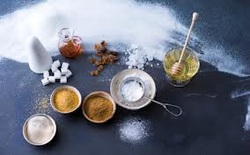
The faster the carbohydrates in a food break down and glucose is released for absorption into the bloodstream, the higher the GI (glucose has a GI of 100), and the higher the insulin response.
Blood glucose is distributed by insulin to all the cells in the body for use as fuel. Foods with a low GI (55 or less) release glucose more slowly and steadily, so the glucose is efficiently taken up and consumed by cells for fuel.
Foods with a high GI (70 and above) release glucose rapidly, resulting in excess glucose in the blood. Once glucose needs are met by all the cells for fuel, the next stop for excess glucose is the liver, where it’s converted to glycogen and stored for future needs. Any remaining excess glucose gets converted into fat and stored in those places where we tend to carry extra fat (stomach, hips, thighs, buttocks, etc.).
So lower GI means slower release of glucose into the blood stream, and a lower corresponding insulin response. However, it’s worth pointing out that a lower GI does not necessarily mean that there’s less sugar in the food. Glucose is only one type of sugar found in foods. Other sugars commonly found in foods include fructose, maltose, lactose (milk sugar = glucose + galactose), and sucrose (table sugar = glucose + fructose).
Foods and sweeteners with a low GI can still have a high amount of sugar. For example, fructose, which is not regulated by insulin, does not trigger an insulin response and has a GI of 19. Compare that to glucose, with a GI of 100. Since fructose is not regulated by insulin, it is metabolized by the liver. When there is an excess of fructose in the liver, the liver can’t process it fast enough and the excess gets converted to fat, just like glucose.
While the following is intended for use as a general guide, it is recommended that you consume any sugar in moderation, regardless of the glycemic index.
Glycemic Index of Various Sweeteners (from lowest to highest):
- Stevia (GI < 1). Stevia is an herb with sweet leaves that are commonly dried and powdered, and can also be used whole. Stevia has no carbohydrates, meaning stevia has no sugar (sugars are the building blocks of carbohydrates). Stevia is recommended as a sweetener for those with diabetes to help control sugar intake.
- Agave nectar (GI = 15). Agave nectar is made by concentrating the sap of the agave plant. Agave nectar is not as healthy as we’ve been led to believe. That’s because agave nectar can have as much as 90% concentrated fructose, making it similar to high fructose corn syrup!
- Fructose (GI = 22). The small amounts of fructose found naturally in fruits and vegetables may help your body process glucose properly. However, excess fructose cannot get processed by the liver and gets converted into fat.
- Brown rice syrup (GI = 25). Brown rice is cooked, cultured with enzymes, usually from dried barley sprouts (malt), then the liquid is strained off and reduced to the desired consistency. Consisting of 45% maltose (a disaccharide with 2 glucose units) 52% maltotriose (a trisaccharide with 3 glucose units), and 3% glucose, the low GI indicates that the glucose is slow to enter the blood stream.
- Raw honey (GI = 30). Honey as it exists in the beehive or by extraction, settling, or straining without adding heat. Raw honey generally has about 38% fructose, 31% glucose, 1% sucrose, and 7% maltose.
- Coconut sugar (GI = 35). Coconut sugar comes from the sap of cut flower buds of the coconut palm. Coconut sugar consists of 70-79% sucrose, and 3-9% each glucose and fructose.
- Palm sugar (GI = 35). Palm sugar comes from sap in stems of various palms, including the Palmyra palm, date palm, sugar date palm, sago palm, or the sugar palm.
- Barley malt syrup (GI = 42). Dark brown thick, and sticky, barley malt syrup comes from sprouted (malted) barley and contains roughly 65% maltose (a trisaccharide with 3 glucose units), 30 percent complex carbohydrate (glucose polysaccharide), and 3% protein.
- Sugar cane juice (GI = 43). Juice extracted from pressed sugarcane that is obtained by crushing peeled sugar cane in a mill. Sugar cane juice consists of 10 – 18% sucrose.
- Lactose (GI = 46). Found in milk, lactose consists of 50% glucose and 50% galactose.
- Maple syrup (GI = 54). Made from the sap of maple trees, maple syrup consists of 65 – 89% sucrose (50% glucose, 50% fructose).
- Evaporated cane juice (GI = 55). According to the Processed-Free America website, the type of evaporated cane juice used by food companies to sell more “natural” products only differs from white sugar (sucrose) in that the evaporated cane juice goes through one less processing step than the white sugar and has slightly more vitamin A, D, and calcium. With true evaporated cane juice, also called Sucanat or Rapadura, the sugarcane juice is evaporated, leaving the sugar crystals and their nutrients intact.
- Black strap molasses (GI = 55). The dark, viscous molasses that remains after maximum sugar extraction from raw sugar cane following the third boiling of sugar syrup. Blackstrap molasses contains sucrose (50% glucose, 50% fructose) plus vitamin B6, calcium, magnesium, iron, and manganese.
- High fructose corn syrup (GI = 62). Corn syrup that reached a desired sweetness by using enzymatic processing to convert some of the glucose into fructose. HFCS 55 (55% fructose, 42% glucose) is mostly used in soft drinks. HFCS 42 (42% fructose, 53% glucose) is used in beverages, processed foods, cereals, and baked goods.
- Sucrose (GI = 64). White sugar, also called saccharose, sucrose has 50% glucose and 50% fructose.
- Brown sugar (GI = 64). Often produced by adding molasses to refined white sugar (sucrose). Brown sugar can also be unrefined or partially refined sugar crystals with some residual molasses. Brown sugar contains 3.5% (light brown sugar) to 6.5% (dark brown sugar) molasses.
- Glucose (GI = 100). Blood sugar is comprised of glucose, which is regulated by insulin.
Resources
- http://www.processedfreeamerica.org/resources/health-news/405-the-truth-about-evaporated-cane-juice
- http://www.panelamonitor.org/media/docrepo/document/files/the-composition-of-sugarcane-juice-and-production-of-granulated-sugar.pdf
- http://kimberlysnyder.net/blog/2012/04/14/the-difference-in-how-fructose-and-glucose-affect-your-body/
- http://en.wikipedia.org/wiki/Unrefined_sweetener
- http://www.fitsugar.com/Glycemic-Index-Where-Do-Sweeteners-Fall-3031565
- http://www.webmd.com/diet/features/the-truth-about-agave
- http://lowcarbdiets.about.com/od/nutrition/a/fructosedangers.htm



 RSS Feed
RSS Feed